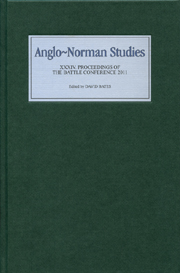Book contents
- Frontmatter
- Contents
- LIST OF ILLUSTRATIONS AND TABLES
- EDITOR'S PREFACE
- ABBREVIATIONS
- Mints and Money in Norman England
- Literate Sociability and Historical Writing in Later Twelfth-Century England
- The Archbishopric of Canterbury and the So-called Introduction of Knight-Service into England
- Lastingham and the Architecture of the Benedictine Revival in Northumbria
- ‘Lanfranc of Bec’ and Berengar of Tours
- The Invention of the Manor in Norman England
- Herbert Losinga's Trip to Rome and the Bishopric of Bury St Edmunds
- Le récit de Geoffroi Malaterra ou la légitimation de Roger, Grand Comte de Sicile
- The Two Deaths of William Longsword: Wace, William of Malmesbury, and the Norman Past
- The Beasts Who Talk on the Bayeux Embroidery: The Fables Revisited
- The Piety of Earl Godwine
Mints and Money in Norman England
Published online by Cambridge University Press: 05 April 2013
- Frontmatter
- Contents
- LIST OF ILLUSTRATIONS AND TABLES
- EDITOR'S PREFACE
- ABBREVIATIONS
- Mints and Money in Norman England
- Literate Sociability and Historical Writing in Later Twelfth-Century England
- The Archbishopric of Canterbury and the So-called Introduction of Knight-Service into England
- Lastingham and the Architecture of the Benedictine Revival in Northumbria
- ‘Lanfranc of Bec’ and Berengar of Tours
- The Invention of the Manor in Norman England
- Herbert Losinga's Trip to Rome and the Bishopric of Bury St Edmunds
- Le récit de Geoffroi Malaterra ou la légitimation de Roger, Grand Comte de Sicile
- The Two Deaths of William Longsword: Wace, William of Malmesbury, and the Norman Past
- The Beasts Who Talk on the Bayeux Embroidery: The Fables Revisited
- The Piety of Earl Godwine
Summary
In 1066 England had a highly developed coinage, which was left almost untouched by the Norman Conquest, in the short term at least. The system documented by Domesday Book in 1086 is essentially that of Edward the Confessor in 1066, with large numbers of moneyers in dozens of urban centres minting silver pennies and making profits for the king and local magnates, lay and ecclesiastical. The moneyers paid fees to obtain their coin dies in London, and the designs on the dies were regularly changed to generate more income from the issue of coins to people who needed money of the latest type. This system survived in its essentials until Henry II's two major reforms of the English coinage in 1158 and 1180, but the apparent continuity between 1066 and 1158 masks a series of innovations and periods of instability.
It is the purpose of this paper to provide a survey of the current state of knowledge on the coinage and currency of England between 1066 and 1158. Mark Blackburn reviewed the coinages of Henry I and Stephen in two magisterial papers published in the 1990s, but research and new discoveries of coins have continued since then at an unprecedented rate. There has been no general survey of the subject in the reigns of William I and William II since the appearance in 1916 of G. C. Brooke's British Museum Catalogue (BMC) of the coins of the Norman kings, although Michael Dolley published an important essay on the consequences of the Norman Conquest for the English coinage in 1966.
- Type
- Chapter
- Information
- Anglo-Norman Studies 34Proceedings of the Battle Conference 2011, pp. 1 - 22Publisher: Boydell & BrewerPrint publication year: 2012



